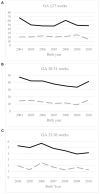Trends in Prevalence and Severity of Pre/Perinatal Cerebral Palsy Among Children Born Preterm From 2004 to 2010: A SCPE Collaboration Study
- PMID: 34093391
- PMCID: PMC8173253
- DOI: 10.3389/fneur.2021.624884
Trends in Prevalence and Severity of Pre/Perinatal Cerebral Palsy Among Children Born Preterm From 2004 to 2010: A SCPE Collaboration Study
Abstract
Aim: To report on prevalence of cerebral palsy (CP), severity rates, and types of brain lesions in children born preterm 2004 to 2010 by gestational age groups. Methods: Data from 12 population-based registries of the Surveillance of Cerebral Palsy in Europe network were used. Children with CP were eligible if they were born preterm (<37 weeks of gestational age) between 2004 and 2010, and were at least 4 years at time of registration. Severity was assessed using the impairment index. The findings of postnatal brain imaging were classified according to the predominant pathogenic pattern. Prevalences were estimated per 1,000 live births with exact 95% confidence intervals within each stratum of gestational age: ≤27, 28-31, 32-36 weeks. Time trends of both overall prevalence and prevalence of severe CP were investigated using multilevel negative binomial regression models. Results: The sample comprised 2,273 children. 25.8% were born from multiple pregnancies. About 2-thirds had a bilateral spastic CP. 43.5% of children born ≤27 weeks had a high impairment index compared to 37.0 and 38.5% in the two other groups. Overall prevalence significantly decreased (incidence rate ratio per year: 0.96 [0.92-1.00[) in children born 32-36 weeks. We showed a decrease until 2009 for children born 28-31 weeks but an increase in 2010 again, and a steady prevalence (incidence rate ratio per year = 0.97 [0.92-1.02] for those born ≤27 weeks. The prevalence of the most severely affected children with CP revealed a similar but not significant trend to the overall prevalence in the corresponding GA groups. Predominant white matter injuries were more frequent in children born <32 weeks: 81.5% (≤27 weeks) and 86.4% (28-31 weeks), compared to 63.6% for children born 32-36 weeks. Conclusion: Prevalence of CP in preterm born children continues to decrease in Europe excepting the extremely immature children, with the most severely affected children showing a similar trend.
Keywords: brain imaging; cerebral palsy; preterm birth; prevalence; severity.
Copyright © 2021 Arnaud, Ehlinger, Delobel-Ayoub, Klapouszczak, Perra, Hensey, Neubauer, Hollódy, Virella, Rackauskaite, Greitane, Himmelmann, Ortibus, Dakovic, Andersen, Papavasiliou, Sellier, Platt and Krägeloh-Mann.
Conflict of interest statement
The authors declare that the research was conducted in the absence of any commercial or financial relationships that could be construed as a potential conflict of interest.
Figures

References
-
- Mailleux L, Klingels K, Fiori S, Simon-Martinez C, Demaerel P, Locus M, et al. . How does the interaction of presumed timing, location and extent of the underlying brain lesion relate to upper limb function in children with unilateral cerebral palsy? Eur J Paediatric Neurol. (2017) 21:763–72. 10.1016/j.ejpn.2017.05.006 - DOI - PubMed
LinkOut - more resources
Full Text Sources
Miscellaneous

